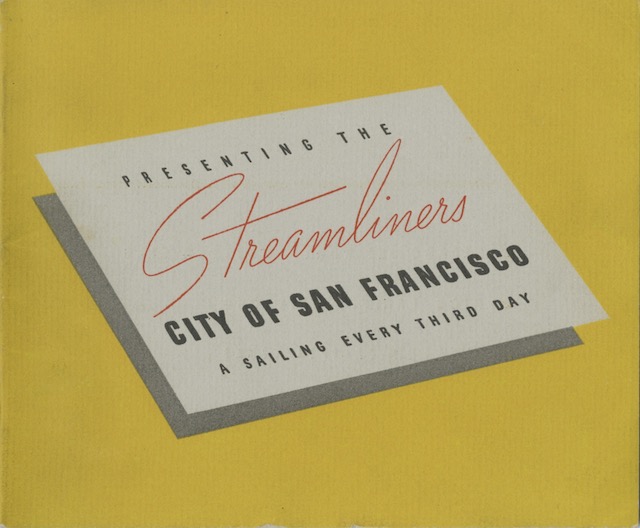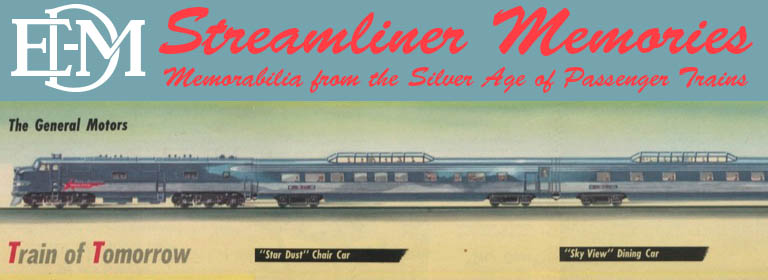This 5″x6″ booklet is a mate to one issued in the same month (July) and year for the City of Los Angeles. Instead of the black-and-white photos found in most Union Pacific name-train booklets, these two contain color images that are unsigned but look like they were done by the Willmarth brothers, who made illustrations for UP between the mid-1930s and the mid-1950s.

Click image to download a 4.8-MB PDF of this 36-page booklet.
Of the sixteen full-color illustrations in this booklet, eleven are identical to ones in the City of Los Angeles booklet. The illustrations of the diners, cafe cars, and lounge cars are different, reflecting differences in the trains themselves.
While the City of Los Angeles diner was gaily decorated in yellow and green with red accents, the City of San Francisco diner used more soothing blues and wood tones. In keeping with the streamliners’ exterior colors, the linens in both illustrations were yellow with red stripes.
The interior of the City of San Francisco‘s club car appears to be decorated in brown and green colors. The City of Los Angeles club car illustrated in the booklet for that train was the Hollywood car, which featured modernistic aluminum interiors, bright red upholstered chairs, and round polarized windows. The COLA booklet noted that the Hollywood car alternated with the Little Nugget lounge car.
The City of San Francisco booklet advertises a coffee shop car that looks like a regular diner, complete with yellow-and-red striped table cloths, decorated with images of the Golden Gate Bridge on the end bulkheads. The City of Los Angeles instead advertised a cafe-lounge car focusing on the lounge end but noting that it contained dining room seating for 32 persons. The tables shown in the illustration do not have cloth table cloths. The City of San Francisco coffee shop car also had seating for 32, but for some reason it required a much larger kitchen that eliminated any room for the 21 lounge seats found in the Los Angeles car.
The only other illustrations that are different are the ones of the train exteriors. The City of San Francisco booklet shows Diesel SF-4 with snow-capped mountains, probably representing the Sierra Nevada, in the background. The City of Los Angeles booklet shows LA-4 with palm trees and what are probably the San Gabriel mountains in the background.
Apart from the different illustrations, the two booklets are arranged completely differently. The City of San Francisco booklet starts with first-class accommodations, followed by first-class feature cars: the diner, lounge, and observation cars. The chair cars, coffee shop car, and rest rooms are in the back. The City of Los Angeles booklet reverses this by starting with the chair cars, then rest rooms, then the coffee shop car, and only then presenting the first-class facilities. This seems backwards; why in particular should the rest rooms be so early in the booklet? In any case, regardless of order the text for these cars is identical in the two booklets.
Using what appears to be a rubber stamp, two amendments were made to these booklets after they were printed. First, both booklets have an illustration of trains’ registered nurse-stewardess, but the stamp says that, “Because of the imminent shortage of nurses for Red Cross and similar purposes related to the National Defense, the stewardess service on all our trains has been discontinued.”
Second, the main dining page of the City of Los Angeles booklet notes that, “A ‘Continental Dinner’ is served on City of Los Angeles Streamliners.” However, the rubber stamp notes that “The Continental Dinner has been discontinued and a table d’hôte dinner is served instead.” Considering the Continental Dinner menu, that was a definite improvement.
Buried in the booklets is a note that the trains included a barber shop, shower-bath, and valet service. While those amenities were once the apex of limited train services, by 1941 they barely rated a footnote. To allay any worries about the dangers of high-speed travel, the booklet also proudly notes that the “power units” of the trains included important safety features, including “windshield wipers, defrosters and sun visors.”
Finally, the booklets end with floor plans of the various cars on the trains, including both the Hollywood and Little Nugget cars in the City of Los Angeles booklet. The Little Nugget car had a barber shop while the Hollywood car did not, which makes me wonder where the barber was located in that trainset. In both trains, the blunt-end observation cars had four bedrooms, a small buffet, and a lounge with 31 seats, all facing the interior of the car, which meant people wouldn’t get to observe very much scenery from those cars.
As shown on the UP booklets page, I’ve previously presented nearly two dozen name-train booklets ranging from 1927 to 1954. Most are 3-1/4″x5-1/4″, but a few are 5″x6″, a size that seemed to be reserved for the introduction of new trainsets. The only other booklet with color illustrations was a 1954 City of Denver booklet, used to introduce the postwar edition of that train.
